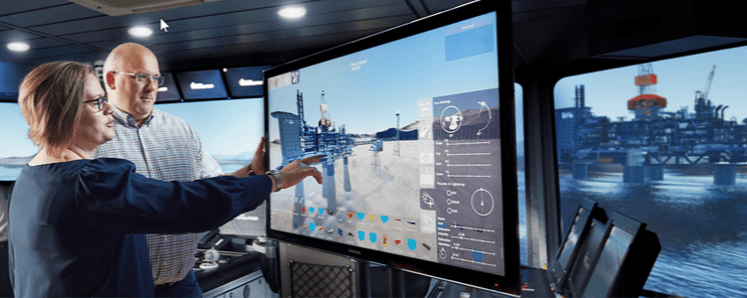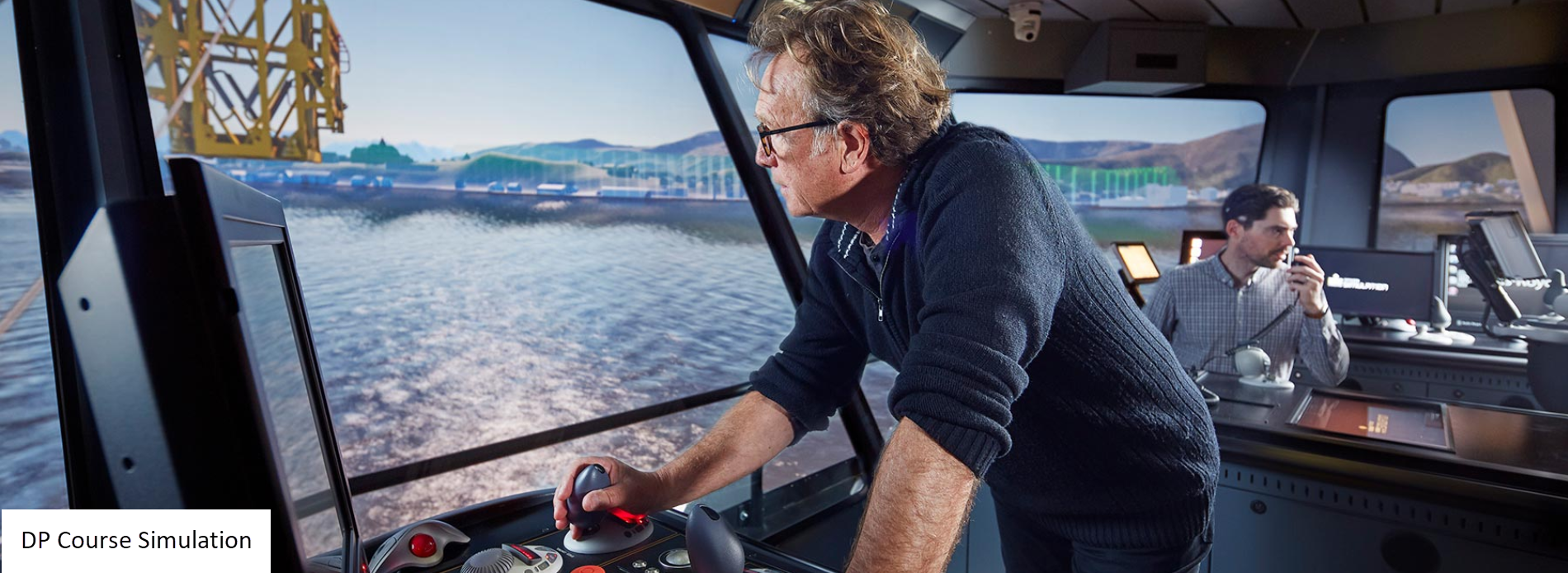 Image by Acorn Photo.
Image by Acorn Photo.
The Offshore Simulation open day on Friday, last week was a big eye-opener. We saw a great example of how the latest simulation technologies can be applied to courses that involve dangerous, highly-technical and expensive on-the-job training. The Offshore Simulation training centre in Western Australia is world-class, and is considered the best of its type for maritime training on the international stage.
Offshore Crane Operator
You're sitting in the cabin of a crane, looking down on the deck of a vessel, all very realistic and life-like. You can see a number of red and blue containers positioned randomly on the deck and a couple more on the adjacent vessel. Tom is your trainer / assessor. He's in the cabin with you. Ben acts as both the deck-hand and the guy who configures your training scenarios. You can talk to Ben via a foot activated press-to-talk pedal on the floor of the cabin.
Your mission is to lift red container no. 33 from vessel A and place it on the deck of the vessel B. You have to position and square it off so that it stacks neatly with the other containers.
Sounds simple right? Well, I've now developed a new level of respect for crane operators. But amazingly, with Tom and Ben's help several of us attending the open day were able to complete the task, without hurting anyone or damaging any equipment.
"OK", says Tom. "That was flat calm water on a nice sunny day. Let's change the conditions and see what happens." Suddenly, the vessels are being tossed on the waves, pitching and rocking like wild broncos. Then comes the rain and the mist. Visibility's now down to 20%.
"Not for me, Tom. I'll leave that scenario to the experts".
Dynamic Positioning Course
 Image by Acorn Photo.
Image by Acorn Photo.
Next we climb the stairs and enter a huge dome that looks like some kind of sci-fi sports stadium from the future. We cross a small gangway and find ourselves in the cool darkness of the bridge of a much bigger vessel. The vessel is operating in a real-life simulation in the port of Aalesund, Norway. Through the bridge windows we look out across the idyllic city nestled at the foot of a huge mountain range.
Underfoot, you can feel the vessel swaying in the calm cold waters. You're sitting in the DP Controller's chair with an array of Rolls Royce controls, dials and gadgets at your disposal. You're here for the Dynamic Positioning (DP) course. You'll be trained in the latest techniques using industry-standard DP equipment. Your skills as a DP controller will be assessed on a range of tasks under varying weather conditions. Today, your mission is to deploy a Remotely Operated Vehicle (ROV) to examine sub-sea plant equipment.
The first problem, you can't see the substation at the bottom of the ocean? Have you reached it? Passed it? Veered off to port or starboard? No problem! This is where the benefits of simulation come into their own. Suddenly the ocean becomes increasingly transparent. Initially you can just make out the sub-sea station at the bottom. Eventually, the ocean is completely removed. The vessels in the harbour float like space ships in mid-air and there, lying on the seabed you can see every detail of the sub-sea station. Now that we have a clear picture of the geography of our operating area we can return the water. But we're still under water. We're seeing the same picture as the ROV, but we can see the ROV too and track its path to the sub-sea station.
Suddenly, a snow flurry appears out of nowhere and the winds pick up. All the vessels in the harbour are pitching and rolling while you concentrate on trying to maintain a level platform to safely deploy your ROV. DP operators can experience and train in scenarios that would be difficult to encounter in real life. Again the learner experience as well as the student's interactions are fully tracked and recorded.
Augmented Simulation
Ever heard of Augmented Simulation? No me either. I've heard of Augmented Reality, like Pokemon GO used for training and development.
As a little segue into the future of Maritime simulation, Mark Pointon, General Manager explains that Offshore Simulator Centre, the Norwegian company who developed the simulation software at the Centre are also on the United Nations “preferred providers” list for SMART City technology. This is used to model and measure all sorts of environmental effects, including power usage, carbon emissions and climate change. The data can then be visualised and superimposed in 3D graphs over affected regions anywhere on earth. The AS technology makes it easily possible to analyse environmental cause and effect scenarios in real time. This takes the simulator way beyond the realms of DP training and assessment, but it does demonstrate the power of augmenting accurate simulations with real-time data.
Key benefits of Simulator training
- Ability to control all parameters of the training environment
- Ability to assess students under highly programmable and life-like conditions
- Safe, doesn't put people and equipment at risk
- Easy to set up and configure
- Ability to track and record everything
- Repeatable and Cost effective
Conclusion
Is simulation an option for your training organisation? Are you looking for something different to engage your team, in a team development exercise? Are you looking for an engaging venue to hold a corporate event?
If you are, this is definitely worth checking out.
Workplace simulation provides a fully tracked, risk-free learning environment. Both the immersive experience and the learner's journey are digital. That means (a) the student experiences real-life scenarios in any conceivable situation, and (b) all interactions are fully recorded.
Mark Pointon highlighted that the advances in simulation technology means the prototyping, development of operational procedures, hazard identification and training of large scale Simultaneous Operations, (SIMOPS) is now possible at optimum performance & accuracy levels.
The cynics among us might argue that, learners could develop a false sense of security, i.e. knowing that they can't do any damage in simulated scenarios. This might lead them to be less attentive in the real world. But you may equally argue that operators who are technically competent are more likely to appreciate the risks and avoidance techniques when taught the safety aspects of their work.
To assess how we might respond if lives and expensive equipment were really on the line we need only look to the lessons learned in the aviation industry. Pilots have used flight-simulator training for many years.
About the Author
 |
Bruno Cozzi and his team have spent the last 20 years designing and developing effective workplace learning management solutions. The diverse mix of skills developed during his career can't be acquired in any academic program. He has a thorough understanding and in-depth knowledge of the vocational education sector and all the related compliance reporting standards. |
|
Cozzi and his team are experts in the delivery of learning and development cloud-based technologies, web applications and web services. That requires extensive knowledge of eLearning, virtual classroom and blended learning technologies and standards. His corporate systems background adds the all-important dimension of business system integration, in a world that demands privacy, data protection, high performance, zero downtime, and user friendly interfaces that work across all devices. But perhaps his most enduring quality is an outstanding ability to distill complex concepts and technologies into highly accessible and simple working solutions. |
|
